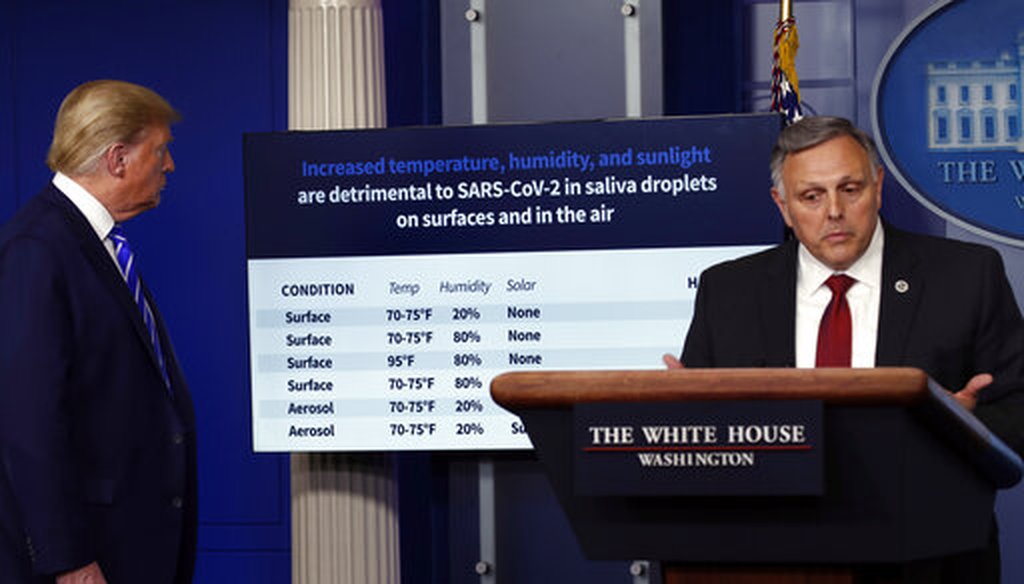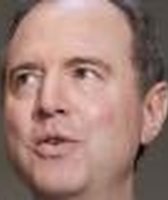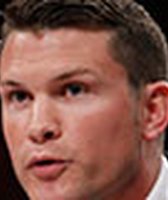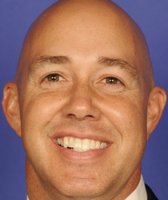Stand up for the facts!
Our only agenda is to publish the truth so you can be an informed participant in democracy.
We need your help.
I would like to contribute

President Donald Trump looks at a chart as Bill Bryan, head of science and technology at the Department of Homeland Security, speaks about the coronavirus in the James Brady Press Briefing Room of the White House, April 23, 2020. (AP)
If Your Time is short
-
The U.S. government conducted a study on the impact of light and heat on COVID-19 on surfaces and the air.
-
The results have not yet been through peer review or published in a journal.
-
The preliminary results do not mean that people should stop social distancing or hand washing.
President Donald Trump celebrated the early results of a federal study looking into the impact of sunlight, heat and humidity on COVID-19. At his nightly White House briefing, Trump suggested the preliminary findings supported his earlier view that the virus would disappear in April.
"I once mentioned that maybe it does go away with heat and light, and people didn’t like that statement very much" Trump said April 23.
Now, Trump said, "it seems like that’s the case." As he touted the new research, Trump suggested scientists would look into bringing light inside the body to treat infections. A health adviser disagreed.
In a March fact-check, we found no conclusive evidence that sunlight could kill or prevent COVID-19. But what about now? In light of the new research, we took a fresh look at what scientists know about sunlight, heat and COVID-19 — and what they think of the federal research so far.
Before diving in, we want to be clear that the results are not considered treatment options for people infected with COVID-19. They don’t change the fact that social distancing and hand washing are still encouraged to reduce the spread between people.
Sign up for PolitiFact texts
What the federal government’s research shows so far
At the White House briefing, a Homeland Security official spoke about research into the impact of the virus on non-porous surfaces, such as door handles or stainless steel, and the air.
William N. Bryan, the department’s acting undersecretary for science and technology, summarized the "emerging results," which have not been published, from a Maryland federal lab.
"Our most striking observation to date is the powerful effect that solar light appears to have on killing the virus, both on surfaces and in the air," he said. "We’ve seen a similar effect with both temperature and humidity as well, where increasing the temperature and humidity or both is generally less favorable to the virus."
Showing slides with certain weather conditions, Bryan explained that scientists measure the decay of a virus by the amount of time it takes for the virus to be reduced by half (half-life).
He shared a slide which showed that at a temperature of 70-75 degrees Fahrenheit, with 20% humidity and no sunlight, the half-life is 18 hours. But that half-life falls to one hour under 95 degrees and 80% humidity.
"If you look at as the temperature increases, as the humidity increases, with no sun involved, you can see how drastically the half-life goes down on that virus," Bryan said. "So, the virus is dying at a much more rapid pace just from exposure to higher temperatures and just from exposure to humidity."
The researchers also studied what the virus does in the air. They suspended the virus inside of a drum and exposed it to various temperatures, humidity levels and sunlight.
The virus in saliva survives best indoors and in dry conditions, Bryan said. The virus "dies the quickest in the presence of direct sunlight."
During the briefing, a reporter asked Bryan if people would be better off outdoors in the warm weather and sun than staying indoors.
"It would be irresponsible for us to say that we feel that the summer is just going to totally kill the virus," Bryan said.
At that point, Trump began cutting in. Trump raised questions about what would happen to the human body under light.
"So, supposing we hit the body with a tremendous, whether it’s ultraviolet or just very powerful light, and I think you said that hasn’t been checked, but you’re going to test it," Trump said. "And then I said supposing you brought the light inside the body, which you can do either through the skin or in some other way. And I think you said you’re going to test that too. Sounds interesting, right?"
Later, Trump asked Dr. Deborah Birx, the White House coronavirus task force coordinator, if she could speak to doctors "to see if there's any way that you can apply light and heat" as a cure."
She replied: "Not as a treatment."
Experts urge caution with unpublished results
Many experts not involved in the study expressed caution about these initial results since they have not been published in peer-reviewed journals. One reason: There are regions in the world where cases have continued despite hot and humid conditions.
The virus continues to circulate in Singapore in hot and humid conditions. Precautionary measures of cleaning surfaces and washing hands should continue, said David Heymann, an epidemiologist at the London School of Hygiene and Tropical Medicine, in an email.
"Respiratory infections generally decrease in the summer months when people are less confined to the indoors, but there is no way at present of predicting whether this newly identified coronavirus in humans will follow that transmission pattern," he said.
The research is in line with what we know of other seasonal respiratory viruses, said Cindy Prins, an epidemiologist at the University of Florida, "But this is research done in controlled lab conditions and it’s not yet peer-reviewed, so you always have to look at that with some caution," she said.
The study remains ongoing, and government officials are preparing to submit reports to peer-reviewed journals over the next couple of days, a spokesman for the Homeland Security Department told PolitiFact.
The seasonality of other viruses isn’t about the hotter temperatures alone. People are also a factor, because they behave differently in the summer by spending more time outdoors and at greater distances from each other. And by the summer, more people may have already been infected with COVID-19 and therefore have some degree of immunity.
Earlier in April, a National Academy of Sciences committee told the Trump administration that studies so far have conflicting results regarding potential seasonality effects. The committee said poor data quality and insufficient time to draw firm conclusions.
Our Sources
C-SPAN, "President Trump with Coronavirus Task Force Briefing," April 23, 2020
Rev, "Donald Trump Coronavirus Press Conference Transcript April 23," April 23, 2020
Washington Post, White House promotes new lab results suggesting heat and sunlight slow coronavirus, April 23, 2020
New York Times, Trump Asks if Sunlight Can Kill Viruses. ‘Not as a Treatment,’ Birx Says. April 24, 2020
CNN White House correspondent Kaitlan Collins, Tweet, April 24, 2020
Dr Peter Hotez at Baylor College of Medicine, Tweet, April 24, 2020
U.S. Centers for Disease Control and Prevention, CDC Collaborative Study: Influenza Seasonality in the Tropics and Sub-tropics, 2015-16
National Academy of Sciences, Engineering and Medicine, Letter to the Executive Office of the President, April 7, 2020
White House, Remarks by President Trump at the White House Business Session with our Nation’s Governors, Feb. 10, 2020
PolitiFact, Fact-checking President Donald Trump on the coronavirus, Feb. 28, 2020
Email interview, David Heymann, Professor of Infectious Disease Epidemiology at London School of Hygiene and Tropical Medicine and Head of the Centre on Global Health Security at Chatham House, London. April 24, 2020
Email interview, John Verrico, a Science & Technology spokesman for the Department of Homeland Security, April 24, 2020
Email interview, Cindy Prins, University of Florida, Master of Public Health Program Director | Assistant Dean for Educational Affairs | Clinical Associate Professor of Epidemiology, April 24, 2020
Telephone interview, David A. Relman, professor of medicine and microbiology & immunology at Stanford, April 24, 2020




































